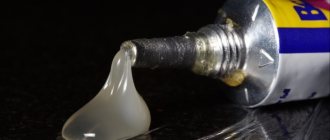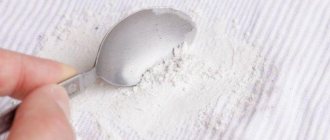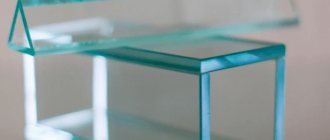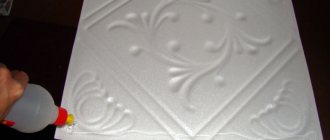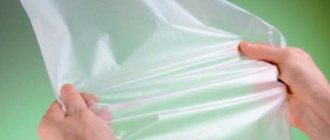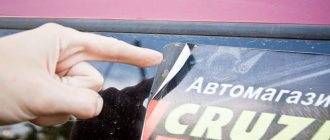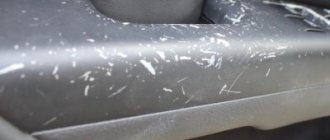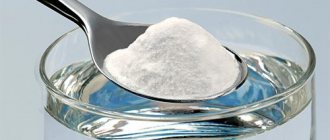Gluing parts is an important part of 3D printing because... Printing a model in parts can minimize the amount of material spent on supports, optimize the strength of the part by changing the direction of layers, and allows you to create larger assemblies due to the fact that the print area is often limited. In this article, we will look at which adhesives are suitable for plastics for 3D printing and under what conditions they should be used.
Safety precautions! Adhesives contain toxic solvents and components; we strongly recommend using personal protective equipment, gloves and, if necessary, respirators; do not allow glue and solvents to come into contact with eyes or skin.
What glue is used to glue PVC to wood?
Usually, all gluing involving PVC (and to wood) is made using Bostic Vinicol 1520 glue. You cannot buy it in stores, but you can buy it from companies involved in the manufacture of PVC boats or their repair. PVC adheres very poorly to painted or varnished surfaces. Gluing is not very reliable.
Interesting materials:
What type of wood to choose for furniture? Which cat breed should you choose? Which portable speaker should you choose in 2022? Which race is better to choose for a hunter in WWII? Which ballpoint pen should I choose for a first grader? What channel width should I choose 5 GHz? What bed width should a teenager choose? Which tax system to choose for individual entrepreneurs in 2022? Which taxation system to choose for wholesale trade? Which dog to choose for a child?
Types of glue for plastic
The adhesive mass is divided into several types, differing in the set of components in the composition and the principle of action on the damaged plane.
In turn, they are divided into the following categories.
Liquid glue for plastic
They are a composition that is made using synthetic solvents.
They provide the working mass with good fluidity and level of adhesion.
- A thin adhesive seam forms on the damaged surface, which becomes almost invisible after the liquid evaporates.
- To ensure that the joint does not deform in the future, it is necessary to maintain a certain period of time.
- On average, this will take from 15 to 24 hours.
- During this time, it is prohibited to exert any influence on the elements being glued.
It is recommended to choose liquid glue for light and large-porous surfaces.
Contact adhesive for plastic
They are produced using 2 components. Epoxy resin and hardener-type reagents are mainly used. As a result, it is possible to obtain a rigid grip.
- When choosing such a composition, it should be taken into account that the adhesive seam is not able to withstand dynamic and vibration loads.
- Deep cracks may appear in the seam area.
- The adhesive mass of this type is distinguished by a high degree of fixation, unlike other liquid compositions.
They contain toxic and chemical components that contribute to poisoning and intoxication. To work with this type of glue, you must follow safety precautions and use a product to protect the mucous membranes and skin.
Reaction glue for plastic
The main difference between this composition is the accelerated polymerization and activation of the components. The desired result can be achieved using an ultraviolet lamp, a small amount of moisture, reducing oxygen or using the external environment.
This glue can form a reliable and durable seam. It can be used for gluing plastic elements.
Hot melt adhesive for plastic
The adhesive mass is presented in the form of a plastic core, which melts under the action of a heat gun and forms a tight connection. During heating, the composition evenly fills cracks and small defects on the plane.
It is recommended to use it for small items and handicrafts.
How to glue plastic panels to the wall
The process of gluing PVC boards is quite simple and can be done independently. Preparatory work and the quality of the glue play a big role here. This is what will ensure that the finish is firmly attached.
First, you should thoroughly clean the walls of dirt, paint, and the like. The surface should be as smooth as possible, since small pits and scratches can significantly reduce the bond strength. If there are defects on the wall, then they must be thoroughly puttied. At the end of the work, it is necessary to coat the surface with a primer and allow the wall to dry.
Before starting work, PVC panels must be cut from the front side so that everything turns out neatly. Fastening is done from a corner or door. The glue itself is applied in dots or dotted lines. If liquid nails are used, then it is better to apply a mesh to the inner surface of the slab. After this, the plate is pressed firmly against the wall; during operation, the panel should not bend too much.
If there are any joints after gluing, it is better to treat them with silicone sealant. Only after finishing the work can the protective film be removed from the material. To make the room look good, you can install ceiling and floor skirting boards.
Carefully and tightly glued PVC panels will decorate the bathroom for many years and protect the walls from excess moisture.
General information
PVC owes its popularity to its positive qualities, among which are the following:
- Long service period (up to 10 years);
- Easy care;
- Environmental friendliness of the material;
- Moisture resistance;
- Fire resistance;
- Additional soundproofing effect;
- Resistance to high and low temperatures;
- A large number of colors and patterns on PVC panels;
- Possibility of attaching panels to a wall or floor made of different materials.
After PVC products are selected as a building material or pipes, it is necessary to purchase glue to attach them. A good composition is moisture resistant, does not crumble and does not change color during use.
Hot glue, fast but unreliable
A quick fix might be hot. It is easy to use, but is not durable and can be used for temporary bonding. When using, be careful when applying to PLA, it may deform the plastic.
Surface preparation: sand, clean and degrease the surfaces to be bonded.
Suitable for PLA, ABS, TPU, not suitable for PETG and nylon.
A great option for gluing large models is to use a 3D pen. In this case, the thread for the handle can be selected from the same material as the printed 3D model.
The best superglue for plastic
The most popular method for gluing broken parts or assembling miniature models is superglue. The name itself speaks of the extraordinary speed of gluing and high strength of the connection. Among the huge variety of small tubes, experts have identified several products.
4 Henkel Super Moment Maxi
Henkel Super Moment Maxi
Instant bonding of plastic and plastic is appreciated by professionals. Not every glue can cope with this task, but the Henkel Super Moment Maxi product is suitable for solving the most difficult problems. It not only sets quickly, but also firmly connects different materials. In addition to polymer parts, the composition can glue metal, cardboard, ceramics and porcelain. The manufacturer has made soft, convenient packaging and an elongated tube spout. This made it possible to apply glue accurately and economically, without the craftsman’s hands being in the solution. The cap is easy to remove, and when closed it prevents air from getting inside the tube.
Experts note the instant setting of superglue, reasonable price and convenient bottle. The product qualitatively combines a wide range of materials, which attracts the attention of professionals. The disadvantage of the product is that it is of Russian origin, which is why its quality is not always stable.
3 Superglue POWER
Superglue POWER
High-quality superglue SILA is sold on the domestic market at an affordable price. At the same time, the composition firmly glues plastic, plastic, porcelain, glass, leather and wood. Thanks to the convenient tube, the required amount of glue can be accurately applied to the surface of the part. This has a positive effect on consumption. Experts note that there is no spreading; the gel does not drip onto other objects or hands. The basis of the product is ethyl cyanoacrylate, to which thickeners are added. After drying, the adhesive seam becomes transparent, which is important when gluing white or colored materials. The strength of the connection during testing was 175 N.
Users speak flatteringly about the effectiveness of the glue, affordable price, and ease of use. The glue does not have a strong odor and sets within a few seconds. Among the disadvantages, consumers note the insufficient thickness of the gel, as well as the presence of a large number of fakes on the market.
2 Economy Express Universal
Economy Express Universal
Chinese superglue Econ Express Universal has instant action. It is easy to use, sets quickly, and is unpretentious in work. The composition is suitable for gluing plastic and plastic, metal and paper, rubber and porcelain. Experts note the high strength of the adhesive joint; it can withstand a load of 210 N. The use of glue is quite standard, the surface of the parts is cleaned and degreased, applied to one of the parts, and the compression time is 5-60 s.
Users note the low price of the composition, good quality and reliable seam. Even under the influence of water, the glued parts do not separate. Consumers also respond positively to the sealed cap, through which air does not penetrate inside. The disadvantages include a pungent odor, which can give you a headache when working in a small, unventilated room.
1 Permatex Super Glue
Permatex Super Glue
Superglue Permatex Super Glue with a gel-like consistency is characterized by high bonding strength to plastic. During comparative tests, experts from the magazine “Behind the Wheel” recognized it as the winner. The destruction of the adhesive seam occurs under a load of 245 N, which significantly exceeds the performance of competitors. It is also noted that the glue is convenient to use when it is necessary to glue thin parts. The product is recommended for gluing hard-to-reach and vertical surfaces. High bond strength is observed on non-porous plastics.
Users are satisfied with the adhesive strength, speed of setting and ease of use. The seam turns out transparent, and in addition to plastic and resin, you can work with metal, rubber and ceramics. The product is economical in consumption, per 6 sq. cm of surface, one drop of the composition is enough.
Popular brands and their prices
The “Moment” brand is very popular among users. The manufacturer offers a wide range of different types: glue for boats, “Moment Crystal”, gel, rubber. The products are of high quality, which is reflected in the price - a tube of 30 g of glue costs about 50-60 rubles.
Soudal produces an equally wide range of PVC adhesives for various purposes. For a fairly affordable price (150-200 rubles), the user can choose glue for any highly specialized purpose.
To connect solid structures, craftsmen often advise purchasing “Secunda” cold welding. Also in the line of adhesives there are excellent types for joining soft materials.
When carrying out a large volume of work, the Thomsit brand will be the best choice. The manufacturer suggests choosing a two-component polyurethane composition suitable for PVC in containers of 5-7 kg, the price is relatively low, about 1,500 rubles, which turns out to be very profitable. The glue does not contain toxins and does not emit harmful substances or solvents.
Thus, choosing a glue for PVC is not such a difficult task. It is worth focusing on the type of surfaces to be glued, operating conditions and price category of the product.
Step-by-step gluing scheme
First you need to determine the type of plastic and the type of glue suitable for it using the methods indicated above. Then proceed directly to repairing the product.
- It is necessary to degrease the surface of the object. This can be done with alcohol, degreaser or soap solution (it is important to use laundry soap).
- Treat the product with a velvet file or fine sandpaper. This action is necessary to increase the wettability of the object and create a stronger bond.
- If two-component glue is used, then the compositions should be mixed only after preparing the parts.
- Do not use brushes made of natural fur to work with the adhesive composition.
- Apply enough glue so that when joining objects, its excess does not ooze out beyond the seam.
For this procedure to produce results, you need to rely on the following points:
- precise determination of the type of plastic and adhesive suitable for it;
- follow the instructions for using the glue;
- wait for the time indicated on the product, do not use the item earlier;
- for products used in conditions of high humidity or for outdoor items, it is better to use a waterproof brand of adhesive;
- If the glue is heat-resistant, the items themselves may not withstand high temperatures.
Methods for gluing plastic without glue
- A heating pad or soldering iron can help in this situation. But the method is only suitable for professionals, since working with a soldering iron requires special skills. They can immediately connect plastic.
- Acetone is also good for this. First you need to degrease the surface with it, moisten the cracks and chips with a brush. The parts must be firmly connected to each other, and acetone must be applied on top. Thanks to this, the plastic dissolves a little, creating a soldering effect, after which the parts are firmly held together.
- Dichloroethane is a toxic substance that easily dissolves plastic. But it must be mixed correctly to form a thick mass that serves as a binding element.
Glue plastic using superglue and soda
Baking soda and super glue interact to create a chemical reaction that enhances the drying and bonding process due to increased temperature. It is important to adhere to accuracy and consistency when carrying out work. After treating the surface with sandpaper, the plastic joint must be covered with baking soda, then pour liquid glue on top, press the parts together and wait 1.5-2 hours. To make the effect more reliable, the already sealed part of the plastic must be treated with fine-grained sandpaper.
Glue plastic with dichloroethane
Since the substance is very caustic, it must be handled with care.
1 way
- First you need to apply a thin layer of the substance to the surface with a brush.
- Wait 10-15 minutes and apply a second layer of product.
Using this method, the dissolved parts of the plastic will merge into a single whole and the effect will be quite good. The disadvantage of this procedure is the possible deformation of the product.
Method 2
- You need to pour the substance and place the pieces of plastic that will stick together in a metal or glass container.
- As soon as you get a thick mass, it must be applied to the junction of the parts. This way the seam and the crack will not be visible.
Glue objects that have decorative elements
Since traces of the substance will be visible on the decorative surface, it is necessary to use the internal gluing technique. This requires fiberglass or other durable material.
- The internal area that will be repaired must be cleaned, then the fabric, which was mentioned earlier, should be well soaked with glue.
- Then apply it to the parts.
If it is not possible to glue the parts from the inside, then rubber or gel glue will do the job. These products take a long time to dry completely, so after bonding, you can easily remove all excess substance.
How to glue plastic using cosmophen
Just as in the previous paragraphs, the surface is cleaned, degreased with alcohol or acetone, and the cosmofen itself is applied. Setting occurs in 1-2 minutes, but complete drying occurs after a day.
Glue the plastic tightly using cold welding
Cold welding can be one-component or two-component. Under the second condition, you need to mix the two substances given to you and you will get an adhesive substance. And one-component welding does not require preparation, it is sold ready for use, you just need to warm it up and proceed to use.
It is important to select the appropriate cold welding marking for the plastic, otherwise the elements of the product will not be securely fastened.
The gluing process is simple. You need to clean the surface of the plastic and apply the product in thin layers. If during these steps the welding has hardened, then a hair dryer will help correct this situation. After heating, it will become elastic again, and you can remove its excess or change its shape.
What type of plastic is there?
First you need to find out what type of plastic the product is made of. Only then can you understand how to repair it. There are always markings on plastic products so that the type of material is clear.
- PET - polyethylene terephthalate is used for packaging liquid and bulk food products. It comes in the form of bags, film, transparent containers.
- HDPE is pure high-density polyethylene, which is used to make bags, shrink film and other low-density products.
- V (PVC) polyvinyl chloride is a non-food plastic that is used to make durable items such as window frames, buckets, etc.
- LDPE - low-density polyethylene is used to create children's toys, bottles for drinks and dairy products, packaging items, and cold water pipes.
- PP - polypropylene, a chemically inactive and heat-resistant plastic, is used for the production of medical items, dishes, kitchen and household utensils, hot water pipes, etc.
- PS is polystyrene; it is used to create disposable tableware and parts of kitchen appliances, and in its foamed state it serves as a very good thermal insulator (foam plastic).
- O Other - plastic that can be recycled, for example if it contains metal or paper.
The best waterproof adhesives
For gluing plastics used outdoors in bathrooms, it is better to use waterproof glue. Among the waterproof compositions, there are varieties that have earned high marks from experts and users.
"Moment plastic"
The Russian grade of heat-resistant and water-resistant adhesive, which is produced under a German license from Henkel, is popular due to its affordable price and ease of use.
The adhesive gel is transparent, so the bond does not stand out on painted plastics. The optimal thickness of the adhesive layer requires the use of 30 grams of glue per square decimeter of two plastic surfaces. Due to its frost resistance, it can be used outdoors. The main disadvantage of Moment Plastic is toxicity. Therefore, it is not used for gluing food plastics (dishes, food processor containers); you only need to work with glue while wearing gloves.
3m scotch weld pr100
American adhesive 3m scotch weld pr100 is based on ethyl cyanoacrylate.
With a short setting time (up to 30 seconds), the waterproof adhesive has good tensile strength (20 N per square millimeter) and a small installation gap (0.15 mm). The adhesive can be used on flat surfaces with smooth finishes. Users consider the high cost to be the main disadvantage of the American product.
Loctite 406
Cyanoacrylate adhesive, developed by chemists of the German company Henkel, is distinguished by its versatility of use, gluing plastics, rubber, rubber.
The liquid consistency of the transparent adhesive composition reduces glue consumption to 4 milliliters per 10 square centimeters of plastic. The penetration of liquid into micropores increases the adhesion of the adhesive layer. Quick hardening of the glue (up to 10 seconds) requires confident working skills. Users consider toxicity and high price to be the disadvantages of glue.
Cosmofen Plus-S
When choosing which glue is best for gluing plastic in the bathroom, PVC pipes, plastic windows, pay attention to Cosmofen Plus-S glue.
Despite the fact that the German product from Weiss belongs to the group of liquid adhesives, silicone additives increase its viscosity, density, and water resistance. The glue is characterized by temperature stability, does not decompose in direct sunlight, sets quickly (in 3-5 minutes), and completely hardens in 12 hours. Users do not consider the strong chemical smell to be a critical drawback.
Liquid
They have low efficiency and can be used for gluing parts that are not subject to heavy loads during operation. To achieve a sufficient level of bond strength, at least 20 hours must pass from the moment of application. The advantage of liquid glue is its gentle effect on working surfaces; it does not deform the plastic of the product.
Solution 2: Soldering
In fact, there are two ways to weld a plastic part at the site of damage - using a hair dryer and a plastic rod, or a soldering iron and a brass or copper mesh. But first, let's talk about the device with which we will carry out the work.
Usually, powerful large hair dryers (also called technical hair dryers) are used for soldering. But they are inconvenient to work with: such hair dryers are bulky, heavy and heat up a large surface. Therefore, we preferred a simple soldering station with a soldering iron and a lightweight compact hair dryer. It is inexpensive, around 3,000 rubles - the price may vary depending on the configuration. We will not need the solder included in the kit, which is used to repair radio components.
How to glue plastic depending on its type?
Please note that in order to choose the right adhesive, you need to determine the type of plastic or plastic. How can I do that? Most often, certain designations are indicated on product packaging. For example PS means polystyrene. In this case, epoxy acrylic or cyanoacrylate is most often used, which is sold under the guise of superglue, where cyanoacrylate is written in small letters.
There are also other types of plastics such as polyethylene and polypropylene. They are designated by the following letters: hdpe, ldpe, PP. In this case, cyanoacrylate may be completely ineffective. There is a plastic with the abbreviation ABS. It is nothing more than a mixture of plastic resins. It is quite easy to glue using epoxy resin or cyanoacrylate glue.
Adhesive for plastic
Types of plastics and glue:
- What to do if nothing is written on the package? In this case, you need to carefully look at the details. For example, plastic is quite plastic, soft, but at the same time fragile. Children's Lego sets are made from it. This is ABS.
- Polystyrene is used to make artificial glass and cheap children's toys.
- Quite good quality polystyrene is used in the manufacture of artificial glass and Chinese-made toys, which are very cheap. That is, it is brittle plastic. What type of plastic are CD cases made from?
- In the case of ABS plastic, that is, from which Lego sets are made, epoxy resin must be used as an adhesive. If it is polystyrene, then gluing must be done using polycement. The wrong choice of glue can cause it to be ineffective.
Repair parts
What does the glue marking mean?
The plastic part being repaired can become capricious if the wrong adhesive mixture is used without taking into account the markings on the product. Therefore, before buying glue, be sure to study the composition of the material. It is important that only taking into account all the nuances will it be possible to carry out high-quality repairs of any type of plastic.
You can buy glue for plastic at any hardware store. However, there is one caveat - usually the markings do not coincide with the symbols that are indicated on plastic products. So, let's look at how manufacturers label adhesives:
- PE - this is the designation for polyethylene;
- PC – these symbols mean polycarbonate;
- PP – designation of polypropylene;
- PVC – marking for polyvinyl chloride;
- PMMA - these symbols indicate organic glass;
- PUR – polyurethane;
- PA 66 - this marking indicates polyamide.
If you have no idea how to glue plastic, then study the accessible, simple instructions in Russian. For people who do not understand the types of markings at all, this solution will be the most optimal.
How to glue plastic to wood, metal, glass?
We recommend choosing glue based on the conditions under which the part will be used.
Adviсe:
- If a fairly rigid coupling is required, but the part will not bend, then we recommend the well-known superglue based on cyanoacrylate, as well as Moment glue. These types of adhesives can easily cope with rigid joints.
- In order to glue flexible parts and parts that are used quite actively, we recommend using contact adhesive such as Moment Plastica, bf-2, bf-4. They are applied in a thin layer to both parts of the product, connected, left for 5 minutes, after which they are pressed against each other. The stronger the pressure, the better the bonding will be achieved.
- How to glue plastic to plastic, wood, glass and metal? In this case, you need to be more careful when choosing glue. In order to connect plastic to metal, it is best to use epoxy and polyurethane compounds.
- That is, those that are sold in sets of two bottles. They must be mixed together, that is, the hardener and the glue itself. UXU twist glue glues plastic to wood and glass very well. When it comes to joining plastic with metals, wood, and rubber, cyanoacrylate-based glue, that is, the well-known superglue, works best.
Special glue
As you can see, when using the right adhesives, you can easily repair car parts, children's toys, and household appliances.

